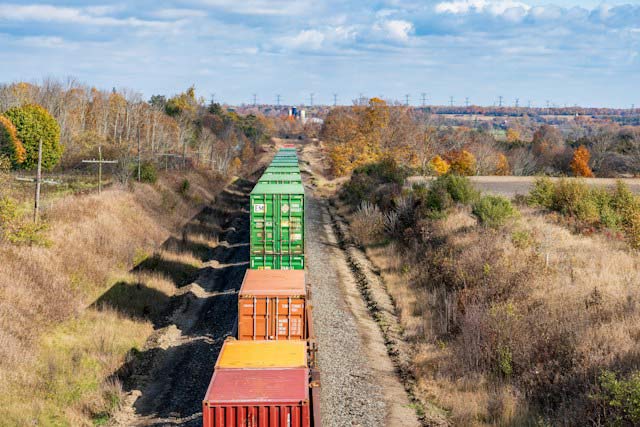Introduction to rail transport
Rail transport (also known as rail transport) is a means of transport that carries passengers and goods on wheeled vehicles running on rails integrated into the tracks. Unlike road transport, where vehicles move on a prepared level surface, railway vehicles (wagons) are guided along the tracks on which they travel. Rails are usually made of steel rails. It is one of the most used modes of transport in the world accounting for approximately 37 percent of global tonne-kilometre (unit of measurement of transport). In contrast to road transport, rail transport is generally considered more environmentally friendly as fuel consumption per passenger and tonne-kilometre is lower. It also has less pollution by weight than road traffic.
Basics of rail transport for a better understanding
Rail transport offers numerous preferences over other modes of transport such as street, discuss or water transport. These benefits incorporate lower outflows of nursery gasses, security, traveler and cargo consolation, moved forward transport speed and ease of utilize. Numerous individuals use rail for transporting merchandise and travel also. So, the main advantages of rail transport is that it is a cost-effective, productive and ecologically inviting way of transporting products and travelers.
In expansion, the natural effect of transport has become a huge issue, and there are numerous reasons why trucks ought to not be utilized for transport. To begin with, rail transport is more vitality proficient. Street transport employs 10 times more fuel than a prepare to transport the same sum of merchandise. Railroads can diminish contamination through zero-emission innovation. Rail shipments are moreover for the most part more secure and require less support than shipments handled by shipping companies.
Be that as it may, like several means of transport, it has a few impediments. Within the case of rail transport, this incorporates the taking a toll of the train and its restricted capacity to reach farther and hard-to-reach places. In any case, it could be a flexible means of transport that has been utilized longer than other shapes of open transport. And there’s nothing in this world that has preferences without impediments. Read more about Essinge Rail’s goods transport for an even bigger understanding of the inner workings of rail freight transport.
Below are the accurate advantages of transportation through rail
1: Payable
Rail transport is regularly more cost-effective than other modes of transport when transporting huge amounts of products over long separations. Trains can carry a noteworthy sum of merchandise in a single travel which makes a difference decrease by and large unit costs. As fuel costs rise, the significance of rail activity increases. The advantage of prepared transport is that the prepare arrives rapidly and the fuel utilization is significantly lower than other means of transport. For example, it can fetch up to 80% less than discuss transport and up to 50% less than street transport. Rail transport moreover diminishes carbon dioxide outflows by up to 50% compared to street transport.
2: Energy efficiency
Trains are intrinsically more vitality effective than numerous other forms of transport. In specific, electric trains can run on power from different sources counting renewable vitality. This proficiency decreases working costs and carbon emanations. Rail transport is an effective way to transport products since it is cheaper than street transport. Trains can move more merchandise at a much lower rate than trucks, making them a boon for most businesses. This is often since there are less costs related with railroad operations and support.
3: Reduce congestion
Rail transport helps reduce road congestion by diverting a significant portion of freight traffic off the road. This not only reduces traffic congestion but also reduces road wear, which reduces maintenance costs and improves road safety.
4: High power
The trains have a large capacity which is ideal for transporting large quantities of goods. This is particularly useful in industries that rely on bulk transportation such as mining, agriculture and manufacturing.
5: Reliability
Prepare transport is eminent for the unwavering quality of timetables and travel times. Trains run on settled tracks, minimizing the effect of climate conditions and outside components that frequently disturb other modes of transport. Trains are not as comfortable and helpful than driving, but they are much more secure. In common, they are much more dependable than cars since they work on a rail framework that’s less prevented by activity or other occasions that can cause delays. Typically, perfect for individuals who need to commute each day to work. In expansion, trains are considered ecologically inviting since they help to decrease carbon outflows caused by cars and fossil fuel transportation.
6: Security
Rail transport is for the most part considered a more secure mode of transport than street transport. Mishaps and collisions seldom happen on trains, which makes a difference guarantee in general street security. Railroads work with government offices and open accomplices to screen all perspectives 24/7. Concurring to a comprehensive security administration arrangement, which is upgraded frequently, railroads share data and distinguish, decrease and react to dangers.
7: Land use
Rail infrastructure requires less land than roads and airports. This makes it an efficient use of resources especially in densely populated areas where land is limited.
8: Long journeys
Prepare transport is reasonable for long-distance travel and offers a helpful and effective way of transporting travelers. In specific, a high-speed rail framework offers an elective to medium-distance discussion transport. Rail transport could be a well-known means of transporting merchandise and travelers over huge geological zones particularly by street and ocean. Trains can regularly transport more merchandise per hour than trucks or ships, making them a cost-effective arrangement for transporting merchandise and individuals.
9: Multimodal connectivity
Rail transport seamlessly integrates with other modes of transport, which facilitates multimodal connections. Goods can be moved relatively easily between trains, trucks and ships while creating an extensive and flexible transport network.
10: Capable of carrying heavy cargo
Trains can carry exceptionally overwhelming cargo and are competent in moving huge numbers of individuals more effectively. Ordinarily, trains can carry numerous tons and travel at a much better speed. In other words, rail transport may be a cost-effective way to transport overwhelming materials over long separations. They moreover have lower mishap rates and make them more secure than other modes of transportation.
11: Benefits to the environment
Compared to street and transport, trains create less nursery gasses per ton of transported merchandise or travelers. Zap of railroads fortifies their natural characteristics. Rail transport can be more ecologically neighborly than other modes of transport, such as street transport or discuss transport. Rail cargo employs around 10% of the vitality that trucks utilize, and rail cars are less likely to discharge carbon dioxide into the discussion. In expansion, trains take less of the time to reach their goal compared to street or stream transport.
Government regulations affecting rail transport
The primary two illustrations of government controls influencing rail transport were the Pacific Railroad Acts of 1862 and 1864. These acts gave support financing for businesses within the shape of arrive gifts and contract bonds based on the number of tracks built within the west. At that time, the bonds were valued at $16,000, $32,000, and $48,000, separately, with costs expanding for tracks found more distant west. In 2022, this sum is around $415,000, $830,000 and $1,250,000 individually when balanced for swelling.
Another case of government control influencing the railroad industry is the Office of Transportation Act of 1966, which set up the Government Railroad Organization (FRA). The recently built administrative body is essentially capable of guaranteeing the security of commercial and traveler trains.
Conclusion
In conclusion, rail transport stands out as an adaptable and economical mode of transport with numerous financial, natural and social benefits. As countries proceed to address today’s transportation challenges, rail proceeds to play a key part in advancing effective and feasible networks. Rail transport is cheaper than street transport for long separations since these cargo trains are able to oblige. In expansion, the transport of products by rail is cheaper due to the lower fuel utilization of the rail. On the other hand, street transport is beneficial for brief separations.









